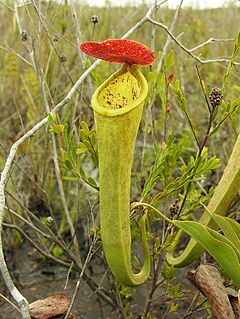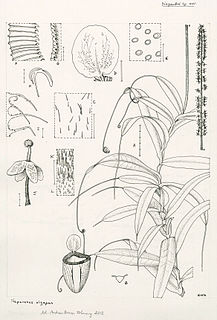
Nepenthes is a genus of carnivorous plants, also known as tropical pitcher plants, or monkey cups, in the monotypic family Nepenthaceae. The genus includes 170 species, and numerous natural and many cultivated hybrids. They are mostly liana-forming plants of the Old World tropics, ranging from South China, Indonesia, Malaysia, and the Philippines; westward to Madagascar and the Seychelles (one); southward to Australia (four) and New Caledonia (one); and northward to India (one) and Sri Lanka (one). The greatest diversity occurs on Borneo, Sumatra, and the Philippines, with many endemic species. Many are plants of hot, humid, lowland areas, but the majority are tropical montane plants, receiving warm days but cool to cold, humid nights year round. A few are considered tropical alpine, with cool days and nights near freezing. The name "monkey cups" refers to the fact that monkeys were once thought to drink rainwater from the pitchers.

Nepenthes mirabilis, or the common swamp pitcher-plant and tropical pitcher plant, is a carnivorous plant species. By far the most widespread of all Nepenthes, its range covers continental Southeast Asia and all major islands of the Malay Archipelago, stretching from China in the north to Australia in the south. The species exhibits great variability throughout its range. One of the more notable varieties, N. mirabilis var. echinostoma, is endemic to Brunei and Sarawak and possesses an extremely wide peristome.
Dr. Charles M. Clarke is an ecologist and botanist specialising in the carnivorous plant genus Nepenthes, for which he is regarded as a World Authority. Clarke has an honours degree in Botany from Monash University in Melbourne, and a Ph.D. in Ecosystem management at the University of New England, in Armidale, New South Wales.

Nepenthes mindanaoensis is a tropical pitcher plant native to the Philippine islands of Mindanao and Dinagat.

Nepenthes rowaniae is a species of pitcher plant endemic to the Cape York Peninsula, Australia. It is closely related to N. mirabilis and was once considered an extreme form of this species.
Martin Roy Cheek is a botanist and taxonomist at the Royal Botanic Gardens, Kew.

Nepenthes tenax is a lowland species of tropical pitcher plant native to northern Queensland, Australia. It is the third Nepenthes species recorded from the continent and its second endemic species. Nepenthes tenax is closely related to the three other Australian Nepenthes species: N. mirabilis, N. rowaniae and N. parvula.
Anderson Park is a 20 hectare arboretum in the suburb of Pimlico in Townsville, Queensland.

Nepenthes micramphora is a tropical pitcher plant known only from Mount Hamiguitan on the island of Mindanao in the Philippines. It is a highland plant growing at elevations of 1100–1635 m.

Alastair S. Robinson is a taxonomist and field botanist specialising in the carnivorous plant genus Nepenthes, for which he is regarded as a world authority. He is currently Manager Biodiversity Services at the National Herbarium of Victoria, Royal Botanic Gardens Melbourne, where he oversees identification botany services, the Library and Artwork components of the State Botanical Collection, and the botanical journal Muelleria, a peer-reviewed scientific journal on botany published by the Royal Botanic Gardens Victoria, for which he is Editor in Chief.

Nepenthes alzapan is a tropical pitcher plant native to the Philippine island of Luzon. It is known from only a handful of herbarium specimens collected in 1925 from submontane mossy forest at an elevation of 1800 m above sea level. It is closely allied to N. bellii and has similarly diminutive pitchers.

Nepenthes cid is a tropical pitcher plant native to the Philippines. It is known only from Bukidnon Province, Mindanao, where it has been recorded as an epiphyte on tall trees at 770 m altitude.
Nepenthes barcelonae is a tropical pitcher plant native to the Philippine island of Luzon. It is known from a single mountain in the Sierra Madre range of Aurora Province, where it grows in stunted submontane forest.
Nepenthes fractiflexa is a tropical pitcher plant endemic to Borneo, where it has been recorded from a small number of localities across Sarawak and Kalimantan. It grows both terrestrially and epiphytically in ridge forest at elevations of 1400–2150 m above sea level. Nepenthes fractiflexa is considerably more diminutive than its putative closest relative, N. mollis. It also differs in its unusual growth habit and plant architecture, producing secondary stems with a frequency rarely seen in the genus, and having activated axillary buds that commonly develop into bract-like prophylls up to 5 cm long. Furthermore, the inflorescence appears to emerge from the middle of the internode, rather than from the leaf axil as is the norm in the genus; it is the first Nepenthes species for which concaulescence has been proposed.

Nepenthes diabolica is a tropical pitcher plant known only from a single mountain in Central Sulawesi, where it occurs at c. 2200–2300 m above sea level. It is characterised by an exceptionally developed peristome and conspicuous, woolly pitcher indumentum. Morphologically it is closest to N. hamata, the only other species from Sulawesi with a similarly elaborated peristome.
Nepenthes putaiguneung is a tropical pitcher plant endemic to highlands of the island of Sumatra in Indonesia. Nepenthes putaiguneung closely resembles in its morphology to N. singalana, however, it differs from the latter with its narrowly spatulate leaves, the upper pitchers with finely lobed peristome that lacks teeth on inner edge, basal crest of the pitcher lid that has a short, tooth-like appendage, the lower pitcher's lid glands that is confined to the midline, and the minutely short bracteole on the pedicel of male flowers. This species also resembles N. mikei but differs by the shape of the leaves, the shape of the lower pitchers, the short, dense ribs on the peristome of the lower pitcher, the prominent grandular crest on the base of the lid of both pitchers, the clustered glands on the midrib of the lid of the lower pitcher, and the minutely short bracteole on the pedicel of male flowers.

Nepenthes candalaga is a tropical pitcher plant endemic to Mt. Candalaga, in the Municipality of Maragusan, Davao de Oro, island of Mindanao, Philippines. This bringing the total number of Nepenthes species in this island to 38, making Mindanao the island with the highest concentration of Nepenthes species in the Philippines. Nepenthes candalaga is closely allied to N. justinae but differs in having a lamina with 2 – 3 longitudinal veins that are parallel with the midrib. Additionally, the orbicular lid of the pitchers, the lid spur tip that is non-bifid, the triangular lid appendage, the short banner-shaped wings below the peristome that covers only a sixth of the trap's anterior eventually becoming ridges towards the trap base, and the absent upper pitcher rim that is widest near the peristome differentiates this species from N. justinae. The species is assessed as Critically endangered due to the threats of deforestation and habitat loss without legislative protection.










